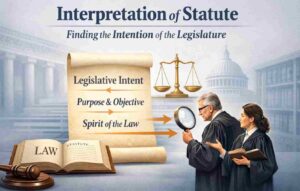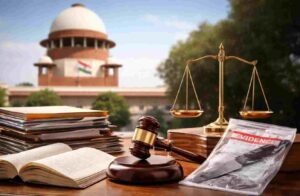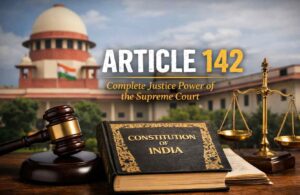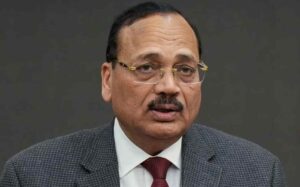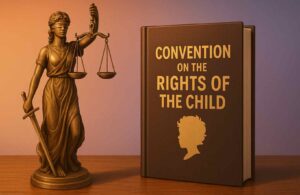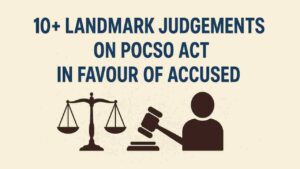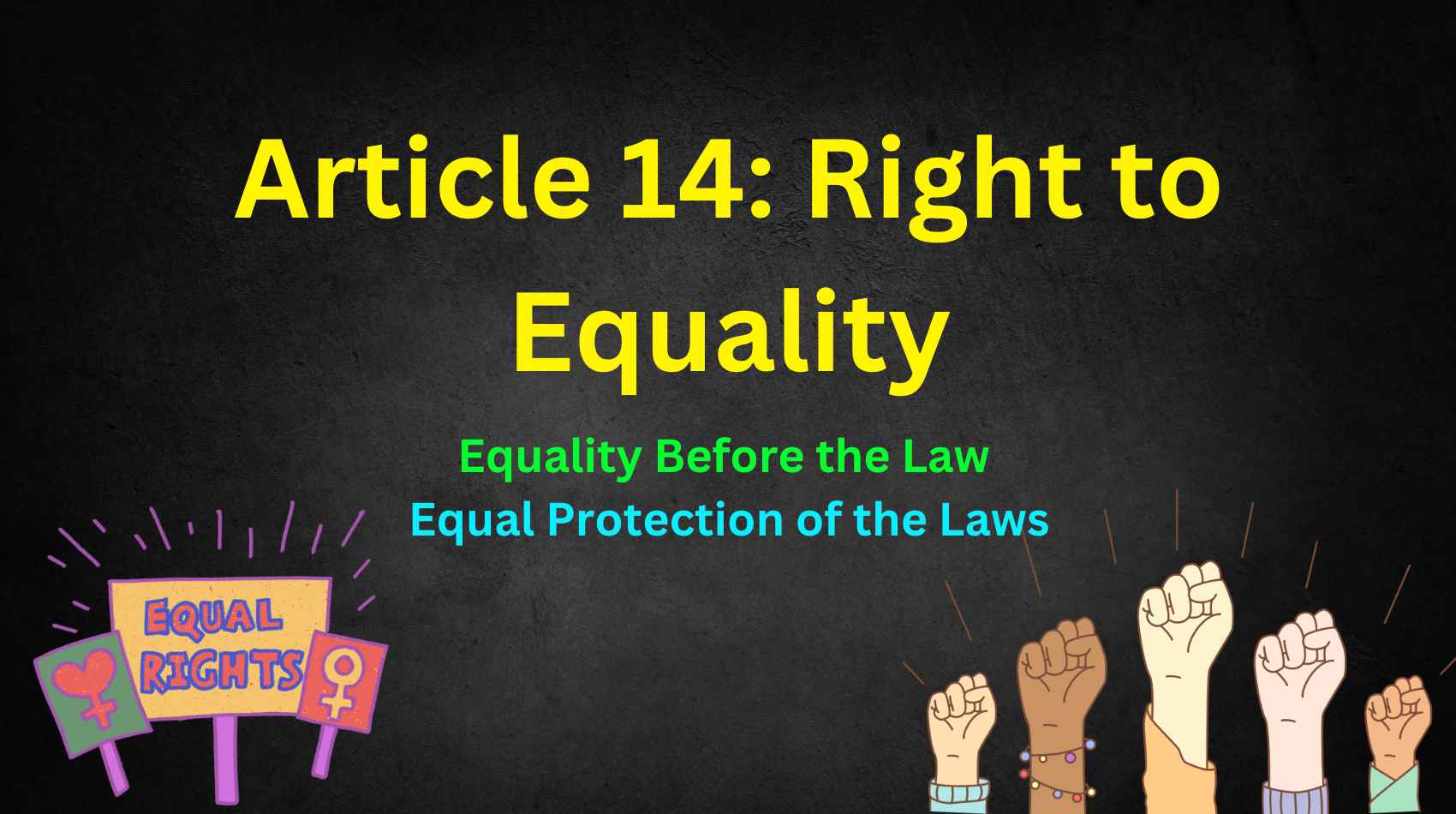Article 14 of the Indian Constitution guarantees equality before the law and equal protection of the laws to all persons. It prohibits discrimination, ensures fairness, and upholds the rule of law, allowing reasonable classification but preventing arbitrary state action.
The right to equality forms the bedrock of a democratic society. In India, Article 14 of the Constitution guarantees “equality before the law and equal protection of the laws” to every person within its territory.
Equality is not merely an abstract ideal but it is a practical necessity that underpins the rule of law in every democratic society.
This succinct yet profound provision ensures that every individual, regardless of caste, race, religion, gender, or other personal characteristics, is entitled to the same legal treatment
Introduction
Article 14 of the Indian Constitution enshrines a simple yet profound promise:
“The State shall not deny to any person equality before the law or the equal protection of the laws within the territory of India.”
At its essence, this article is a commitment to fairness and justice. It ensures that every individual—regardless of race, religion, caste, gender, or economic background is treated with the same dignity and respect under the law.
The guarantee of equality is not confined merely to a formal declaration; it is a dynamic instrument through which the judiciary has continuously sought to correct injustices and uphold human dignity.
Over the decades, this provision has not only protected citizens from arbitrary state action but also evolved through judicial interpretation to address modern challenges in discrimination and inequality.
In a country as diverse as India, where historical social stratifications once ruled society, Article 14 stands as a powerful tool for social transformation.
Its application is not limited to the letter of the law but extends into the broader realm of public policy and administrative practices, ensuring that the rights of all individuals are safeguarded in every sphere of life.
Historical Origins and International Influences
Global Foundations of Equality
The modern concept of equality before the law has deep historical roots and is a synthesis of ideas drawn from various legal traditions:
- The Magna Carta (1215): One of the earliest documents asserting that no ruler is above the law, the Magna Carta laid the foundation for the modern rule of law by proclaiming certain liberties for all free men. This document was revolutionary in curbing the absolute power of the monarch and establishing that even the sovereign must obey the law.
- English Common Law: Developed over centuries, English Common Law introduced the principle that all individuals, regardless of status, are subject to the same legal rules. This idea of “equality before the law” became a cornerstone in legal systems that later influenced many constitutional documents.
- The United States Constitution (Fourteenth Amendment): The Equal Protection Clause of the Fourteenth Amendment to the U.S. Constitution mandates that no state shall “deny to any person within its jurisdiction the equal protection of the laws.” This clause provided a blueprint for India’s understanding of equal protection and inspired the drafters of the Indian Constitution.
- The Universal Declaration of Human Rights (1948): Article 7 of the UDHR proclaims that “all are equal before the law and are entitled without any discrimination to equal protection of the law.” This international standard reinforced the global consensus on the importance of equality as a fundamental human right.
Incorporation into the Indian Constitutional Framework
When the Constituent Assembly of India began its monumental task after independence, it sought to remedy centuries of injustice and discrimination.
The framers were keenly aware of the deep social divisions like caste, religion, and gender that had long plagued the nation.
Drawing on international principles and local exigencies, they enshrined the right to equality in the Constitution.
Article 14, as part of Part III, which deals with Fundamental Rights, was not a mere transplantation of foreign ideas; it was adapted to meet the unique needs of the Indian society.
The objective was to establish a level playing field for all, ensuring that no person or group could claim a privileged position simply by virtue of birth or social status.
In doing so, the Constituent Assembly showed that equality was not only a legal ideal but a vital ingredient for a just, progressive, and inclusive society.
Scope and Features of Article 14
Universal Applicability
A striking feature of Article 14 is its broad, universal scope:
- Inclusivity: The right to equality applies to all persons within the territory of India, including citizens, non-citizens, natural persons, and even juristic entities such as companies and associations.
- Comprehensive Protection: Whether the issue arises in legislative enactments, administrative decisions, or executive actions, Article 14 serves as a shield ensuring that no action by the State is arbitrary or discriminatory.
- Global Comparison: Unlike some jurisdictions that limit equal protection to citizens only, India extends this fundamental right universally, thereby reinforcing its commitment to human dignity and fairness for everyone.
Dynamic Interpretation and Evolving Jurisprudence
The interpretation of Article 14 is not static; it is a living, evolving principle. Over the years, Indian courts have:
- Expanded the scope of “equal protection” to cover private actions with significant public impact.
- Adopted a dynamic interpretation that safeguards emerging rights, including those related to sexual orientation, transgender identity, and other evolving social categories.
- Adopted an approach that is sensitive to the context and demands of modern society, ensuring that legal interpretations remain relevant in the face of societal changes.
Formal vs. Substantive Equality
Article 14 embodies a dual approach:
- Formal Equality: This is the idea that all individuals are subject to the same legal rules—no one is above the law.
- Substantive Equality: Recognizing that treating everyone identically might perpetuate injustice, substantive equality allows for reasonable classification. In other words, while the law must be applied uniformly, it also permits the State to differentiate between groups if there is a rational basis for doing so.
The principle of substantive equality is particularly significant in a society with vast socio-economic disparities. It acknowledges that merely treating all individuals the same may not yield fairness if underlying inequalities persist.
The Dual Pillars of Article 14: Equality Before the Law and Equal Protection
Equality Before the Law
The phrase “equality before the law” has its origins in the English Common Law tradition. It is a negative guarantee that no individual or group is to be given special privileges in the eyes of the law.
In practice, this means that every person, regardless of rank or social status, is subject to the same legal processes and protections.
Implications:
- Uniform Application: No one is exempt from the law, not even high-ranking officials or those in positions of power.
- Prevention of Arbitrary Treatment: By ensuring that everyone is treated equally in legal proceedings, the principle prevents misuse of power by public officials.
- Judicial Accountability: Even actions taken by State authorities are subject to judicial review if they deviate from the principle of equality.
The Air India vs. Nargesh Meerza case illustrated that even corporate regulations affecting employment must be applied uniformly, without arbitrary exceptions based on gender.
Equal Protection of the Laws
“Equal protection of the laws” is a positive assertion, meaning that the State must not only refrain from discrimination but must actively ensure that all individuals in similar circumstances receive the same treatment.
This principle allows for the creation of laws that recognize differences when justified by a rational basis.
Implications:
- Substantive Fairness: This provision enables the State to address historical disadvantages by adopting measures that provide for affirmative action, provided they are based on reasonable and intelligible classification.
- Flexibility in Legislation: The State can differentiate among groups, but such differentiation must have a clear, rational nexus to the purpose of the law.
- Judicial Oversight: Courts review laws and administrative actions to ensure that any classification is not arbitrary and that it meets the twin tests of intelligibility and rationality.
In Navtej Singh Johar vs. Union of India, the Court observed that the criminalization of consensual homosexual conduct, when applied uniformly, discriminated against sexual minorities, thus violating the promise of equal protection.
Protection Against Arbitrariness
The Doctrine of Non-Arbitrariness
The Supreme Court has been consistent in emphasizing that the State must act reasonably and not arbitrarily. In E.P. Royappa v. State of Tamil Nadu (1973), the Court famously remarked that:
“Equality is a dynamic concept … and arbitrariness is its sworn enemy.”
This doctrine of non-arbitrariness mandates that any decision by the State, be it legislative, administrative, or executive must be free from capriciousness and be based on logical, consistent principles.
If a decision is found to be arbitrary, it automatically falls foul of Article 14, regardless of whether the classification appears justified on its face.
The Doctrine of Legitimate Expectation
Closely linked with non-arbitrariness is the doctrine of legitimate expectation. Under this doctrine, if the State makes a promise or representation through policy or practice, individuals may develop a legitimate expectation that the State will honor that promise.
Should the State deviate arbitrarily from this promise, the affected parties can seek judicial redress on the grounds of violating their right to equality.
- Example: If the government introduces a welfare scheme targeting a specific community, the abrupt withdrawal of benefits without due process could be challenged as an arbitrary act that violates Article 14.
Judicial Test of Reasonable Classification
To determine whether a classification is constitutionally valid, courts apply the test of reasonable classification, which requires:
- Intelligible Differentia: The classification must be based on a clear, logical distinction between those who are included and those who are excluded.
- Rational Nexus: There must be a direct connection between the classification and the objective of the law.
Only when both these criteria are met can a classification be deemed reasonable. Otherwise, even if the State claims a legislative purpose, the classification will be struck down as arbitrary.
Intelligible Differentia and Reasonable Classification in Practice
What is Intelligible Differentia?
An “intelligible differentia” refers to the clear and rational basis on which a law distinguishes between groups.
This element is crucial because it ensures that the State’s classification is not based on whim or prejudice, but on substantive differences relevant to the law’s objective.
Examples:
- Reservation Policies: The classification of beneficiaries in reservations for Scheduled Castes (SCs), Scheduled Tribes (STs), and Other Backward Classes (OBCs) is based on historical disadvantage and socio-economic backwardness.
- Taxation Schemes: Progressive tax systems classify individuals by income levels—a rational nexus exists between income disparity and the need for a differential tax rate.
Class Legislation vs. Reasonable Classification
The Constitution strictly prohibits class legislation that arbitrarily favors a particular group without a rational basis.
However, reasonable classification is an exception that allows the State to differentiate between groups if:
- The classification is based on intelligible differentia.
- There is a rational connection between the classification and the objective pursued.
Case Studies:
- Sri Srinivasa Theatre vs. Government of Tamil Nadu (1992): The Court held that a law must have a rational nexus between the classification and the legislative purpose. Any classification without an intelligible differentia is arbitrary and unconstitutional.
- Pramod Pandey vs. State of Maharashtra (2020): Here, the Supreme Court struck down an age-based restriction in the film industry, finding that similar-age individuals in other sectors were not subject to the same regulation. The absence of an intelligible differentia made the restriction arbitrary.
- Madan Mili vs. Union of India (2021): The differentiation between vaccinated and unvaccinated individuals for COVID-19 restrictions was found lacking in rational nexus, rendering the classification arbitrary.
- Elephant G. Rajendran vs. the Registrar General (2023): A junior advocate’s exclusion from certain facilities was ruled arbitrary as the classification was not supported by any rational or substantial basis.
Through these cases, the judiciary has consistently reaffirmed that while the State may classify for valid purposes, such classifications must be justified by both an intelligible differentia and a rational relation to the objective.
Administrative Discretion and the Test of Reasonableness
The Nature of Administrative Discretion
Administrative discretion is inherent in governance. Legislatures and executive bodies must often decide on a case-by-case basis how best to implement policies.
However, such discretion is not unchecked. Under Article 14, the exercise of discretion must adhere to the principles of fairness, non-arbitrariness, and reasonableness.
Judicial Scrutiny of Discretionary Decisions
The judiciary has played an active role in ensuring that the State’s discretionary powers are not abused. When an administrative decision is challenged, courts examine:
- The Process: Whether the decision-making process was transparent and provided an opportunity for affected individuals to be heard.
- The Basis: Whether there is a rational nexus between the decision and the policy objective.
- The Outcome: Whether the decision results in a manifestly arbitrary or discriminatory outcome.
- Example: In disputes regarding the termination of government employees or the allocation of public resources, courts have struck down decisions where officials acted on the basis of personal bias or without a reasonable explanation.
The Test of Reasonable Discretion
The “test of reasonable discretion” requires that any administrative action must not be:
- Capricious: Decisions must be based on reason, not on random or biased factors.
- Disproportionate: The measures taken must be proportionate to the objective pursued.
- Unfair: There should be no violation of the principles of natural justice or any discrimination against individuals in similar circumstances.
If a decision fails these tests, it may be declared unconstitutional under Article 14. This review mechanism ensures that public administration remains accountable to the fundamental principles of equality.
Exceptions and Special Provisions
While Article 14 broadly prohibits discrimination, the Constitution also recognizes that complete uniformity in every sphere of public life may not be feasible or even desirable. Hence, several exceptions exist.
#1 Legitimate Exceptions Through Reasonable Classification
- Reservation Policies: Affirmative action measures, such as reservations for SCs, STs, and OBCs, are an example of reasonable classification. These policies are designed to correct historical injustices and provide opportunities to those who have been systematically marginalized.
- Taxation: Progressive taxation is another instance where the law treats citizens differently based on income levels. Here, the State’s objective is to ensure equitable distribution of the tax burden, which is a rational and justifiable classification.
#2 Special Privileges for Constitutional Functionaries
Certain constitutional offices are granted specific privileges to ensure the smooth functioning of the State. These include:
- Immunity for the President and Governors: Under Article 361, the President and Governors are immune from judicial proceedings regarding actions undertaken in their official capacities. This immunity is designed to protect the integrity of their office and ensure that their decisions are not unduly hindered by litigation.
- Legislative Privileges: Articles 105 and 194 grant immunity to Members of Parliament and State Legislatures for their speeches, opinions, and votes in the legislature. This protection is essential to preserve the freedom of debate and ensure that legislative processes are not stifled by frivolous lawsuits.
#3 Diplomatic Immunity and International Considerations
Foreign diplomats, ambassadors, and international organizations enjoy immunity from local jurisdiction, ensuring that international relations and diplomatic functions are not disrupted by domestic legal proceedings.
Such immunities, based on international conventions, are recognized as exceptions under Article 14, provided they do not conflict with the fundamental rights of citizens.
#4 Emergency Provisions
During times of national emergency, certain fundamental rights, including aspects of Article 14, may be temporarily suspended under strict conditions.
The suspension is allowed only to the extent necessary to maintain national security or public order, and it is subject to judicial oversight.
Article 14 and Global Equal Protection Doctrines
Comparison with the U.S. Equal Protection Clause
The U.S. Constitution’s Equal Protection Clause of the Fourteenth Amendment has many similarities with Article 14.
Both require that the State treat individuals in similar circumstances equally. However, differences in approach exist:
- Scope and Applicability: While the U.S. clause applies primarily to state actions, Article 14 extends its protection universally to all persons, including non-citizens and private entities in cases where there is significant state involvement.
- Judicial Interpretation: U.S. jurisprudence has developed a tiered approach to equality, subjecting laws to different levels of scrutiny based on the classification. Similarly, Indian courts have adopted tests for reasonable classification and non-arbitrariness, ensuring that differential treatment is justified.
In Chiranjit Lal Chowdhuri v. Union of India (1950), the Indian Supreme Court explicitly compared Article 14 to the U.S. Equal Protection Clause, highlighting that both serve to prevent arbitrary discrimination.
Other International Jurisdictions
Several countries incorporate similar principles:
- European Convention on Human Rights: The European Court of Human Rights, through Article 14 of the Convention, protects against discrimination, although it is typically interpreted in conjunction with other rights.
- South Africa: The South African Constitution is renowned for its robust protections against discrimination. It provides extensive grounds for equality and has been influential in shaping global debates on human rights.
Landmark Judgements on Article 14
The evolution of Article 14 has been significantly influenced by a series of landmark judgements that have expanded and refined its interpretation.
Air India vs. Nargesh Meerza (1978)
- Background: Air India’s service regulations imposed conditions that resulted in the termination of employment for air hostesses based on factors such as age, marital status, and pregnancy. These conditions were challenged as discriminatory.
- Judicial Reasoning: The Supreme Court held that such provisions were not only arbitrary but also infringed on multiple constitutional rights. The Court found that imposing termination based on marriage or pregnancy was irrational and violated the principles of equal protection. It underscored that employment regulations must be designed in a way that respects the dignity and autonomy of the individual.
- Impact: This judgment became a benchmark in establishing that gender-based employment rules must be scrutinized under Article 14. It laid the groundwork for future cases where discriminatory employment practices were challenged in court.
Indian Young Lawyers Association vs. State of Kerala (2006)
- Background: The Sabarimala temple ban, which prohibited women between the ages of 10 and 50 from entering the temple, was challenged on grounds of discrimination.
- Judicial Reasoning: The Court ruled that the practice violated Articles 14, 15, and 17. In its detailed analysis, the Court held that while religious practices are entitled to a degree of deference, they must not override the fundamental right to equality. The decision was based on the understanding that excluding women from the temple on the basis of menstruation was an arbitrary classification that had no rational nexus with the religious objective purportedly served by the ban.
- Impact: This case has had a far-reaching impact on gender rights in religious contexts and set a precedent for challenging traditional practices that are discriminatory in nature.
Tamil Nadu Electricity Board vs. R. Veeraswamy (1999)
- Background: The introduction of a new pension scheme and its non-retroactive application led to questions about the validity of treating different groups of employees unequally.
- Judicial Reasoning: The Supreme Court held that the differentiation was justified based on the rational nexus between the timing of retirement and the benefits provided by the new scheme. The Court emphasized that if a classification is based on a reasonable criterion and does not result in arbitrary discrimination, it is sustainable under Article 14.
- Impact: This judgment reinforced the doctrine of reasonable classification and highlighted that not every instance of differential treatment amounts to inequality.
Shayara Bano vs. Union of India (2016)
- Background: The practice of Triple Talaq, which allowed a Muslim man to divorce his wife instantly by pronouncing “talaq” three times, was challenged as discriminatory.
- Judicial Reasoning: The Court held that Triple Talaq was inherently arbitrary and violated several fundamental rights, including those guaranteed under Articles 14, 15, 21, and 25. The judgment was built on the premise that any law or practice that systematically undermines the dignity and rights of a particular group cannot be sustained under the Constitution.
- Impact: This landmark judgment has become a crucial reference point in the ongoing debate about personal laws and gender equality. It also illustrates how Article 14 interacts with other fundamental rights to provide comprehensive protection.
Navtej Singh Johar vs. Union of India (2018)
- Background: Section 377 of the Indian Penal Code, which criminalized consensual homosexual conduct, was challenged on grounds of discrimination.
- Judicial Reasoning: The Supreme Court held that Section 377 violated the constitutional guarantees of equality, privacy, and dignity by imposing arbitrary and discriminatory sanctions on the LGBTQ+ community. The reasoning was anchored in both the formal and substantive dimensions of equality. The judgment expanded the interpretation of equal protection to include sexual orientation, thereby decriminalizing consensual same‑sex conduct.
- Impact: This historic ruling has dramatically altered the landscape of LGBTQ+ rights in India, marking a progressive step in the evolution of Article 14.
Joseph Shine vs. Union of India (2018)
- Background: Section 497 of the Indian Penal Code, which penalized a man for adultery while leaving women unaccountable, was challenged as discriminatory.
- Judicial Reasoning: The Court declared Section 497 unconstitutional because it perpetuated gender inequality by treating women as the property of their husbands. It held that the law violated the principles of equal protection by denying women the autonomy to control their personal relationships.
- Impact: This decision has been pivotal in the reformation of personal laws and in promoting gender equality by ensuring that both men and women are held to the same standards under the law.
International Reflections on Equality
The U.S. Equal Protection Clause Versus Article 14
A comparative analysis between Article 14 and the U.S. Equal Protection Clause reveals both similarities and differences:
- Scope: The U.S. clause primarily protects citizens against state discrimination, whereas Article 14 extends its protection universally to all persons within India.
- Interpretative Approaches: U.S. jurisprudence employs a tiered scrutiny system—ranging from rational basis to strict scrutiny—depending on the nature of the classification. In India, courts have similarly applied tests of intelligible differentia and rational nexus, though Indian courts have been more willing to allow reasonable classification for affirmative action.
- Cultural and Social Context: In both jurisdictions, historical contexts have shaped the interpretation of equality. While U.S. law evolved through civil rights struggles, Indian law emerged from the need to overcome deep-seated social inequalities.
Lessons from European Jurisdictions
European human rights law also provides an instructive comparison:
- European Convention on Human Rights (ECHR): Article 14 of the ECHR, read in conjunction with other rights, protects against discrimination. European courts have developed an extensive body of case law interpreting what constitutes “reasonable” classification.
- Social Democracies: Countries such as Sweden and Germany have laws that actively promote social welfare and equality. Their legislative frameworks, while different in detail, reflect the same underlying principles of non-discrimination and equal protection that are central to Article 14.
Global Impact and the Pursuit of Utopia
Despite cultural and legal differences, the universal aspiration for equality remains. Declarations like the Universal Declaration of Human Rights have set global standards that influence domestic jurisprudence.
The ongoing debates about the ideal of equality—its inherent paradox and its practical application—are not unique to India but resonate across the world.
Socio-Economic Dimensions of Equality Under Article 14
Addressing Historical Injustices
In India, the legacy of social stratification whether through caste, religion, or gender has left deep scars. Article 14 has been instrumental in:
- Correcting Historical Disadvantages: Affirmative action policies such as reservations are designed to uplift historically marginalized groups. These measures, justified under the doctrine of reasonable classification, recognize that treating everyone identically does not necessarily yield substantive equality.
- Empowering the Disadvantaged: Judicial interventions have repeatedly stressed that the State must not only refrain from discrimination but also take proactive measures to ensure equality of opportunity. Such policies are seen as necessary for bridging the socio-economic divide and promoting social justice.
Economic Equality and Business Regulation
While primarily concerned with social justice, Article 14 also influences economic regulation:
- Taxation and Economic Policies: Progressive tax laws, subsidies, and differential treatment in economic policies are often subject to scrutiny under Article 14. The State’s ability to classify citizens based on income levels or economic status must meet the test of reasonableness.
- Business and Employment Regulations: Regulations that affect the rights of employees or business entities are likewise evaluated for their adherence to the principles of equality. Courts have struck down regulations that appear to favor one class of employees or businesses over another without a rational basis.
Intersectionality: Gender, Sexual Orientation, and Beyond
Recent judicial trends indicate a broader, more inclusive interpretation of Article 14:
- Transgender and LGBTQ+ Rights: Landmark decisions such as Navtej Singh Johar have expanded the understanding of equality to encompass sexual orientation and gender identity. These rulings emphasize that discrimination against sexual and gender minorities is inconsistent with the constitutional mandate of equal protection.
- Intersex and Non-Binary Persons: Emerging legal challenges have sought recognition of the rights of intersex and non-binary individuals, arguing that a narrow interpretation of equality based solely on traditional gender categories is outdated. Courts are increasingly receptive to arguments that call for a more expansive understanding of equality in line with modern social realities.
Academic Critique and the Paradox of Equality
The philosophical and academic debate surrounding equality is as old as democracy itself:
- The Paradox of Equality: As noted by thinkers such as Navroz Seervai and encapsulated in literary works like George Orwell’s Animal Farm, there is an inherent tension between the ideal of complete equality and the practical realities of human society. Although declarations often assert that “all men are created equal,” history—and even the text of many constitutions—reveals that absolute equality is a theoretical ideal rather than an achievable state.
- Practical Implications: Despite its idealistic overtones, Article 14 remains a pragmatic tool for challenging discrimination. Its adaptability allows the courts to balance idealistic principles with real-world exigencies, ensuring that while absolute equality may remain elusive, the State is held accountable for unjust or arbitrary treatment.
Legislative and Administrative Developments Shaping Article 14
Legislative Evolution and Amendments
Since 1950, various amendments and legislative enactments have influenced the practical application of Article 14:
- Affirmative Action Legislation: Laws related to reservations in education and employment have been developed to address historical inequities. Although controversial at times, these measures have been largely upheld by the judiciary under the doctrine of reasonable classification.
- Special Provisions and Exceptions: Statutory provisions granting privileges to constitutional functionaries and diplomatic immunities demonstrate that the Constitution permits certain deviations from absolute equality, provided they are justified by legitimate state interests.
Administrative Reforms and Policy Initiatives
Beyond legislation, administrative reforms have also played a key role:
- Transparency and Accountability: Over the years, there has been a significant push towards greater transparency in administrative decision-making. Mechanisms such as Public Interest Litigation (PIL) and the use of writ petitions under Articles 32 and 226 empower citizens to challenge arbitrary state actions.
- Modernization of Public Administration: Efforts to modernize public administration—such as digital governance and streamlined regulatory frameworks—aim to reduce discretion and improve fairness, aligning state practices more closely with the principles of Article 14.
Judicial Oversight and the Role of Public Interest Litigation
Judicial review remains a vital mechanism for enforcing Article 14:
- Writ Jurisdiction: The Supreme Court and High Courts have been proactive in issuing writs to address violations of fundamental rights. This active judicial oversight is critical in maintaining the balance between state authority and individual freedoms.
- Impact of PILs: Public Interest Litigations have enabled the courts to address systemic issues affecting large segments of society. PILs have been instrumental in challenging discriminatory policies and ensuring that the principles of equality are upheld in public governance.
Contemporary Challenges and Future Directions
Emerging Areas of Discrimination
- Digital and Data Discrimination: With the rise of digital technologies, issues such as data privacy, algorithmic bias, and digital exclusion have come to the fore. Questions arise about whether state or private actions in the digital realm may violate Article 14’s guarantees.
- Economic Inequality: Despite economic growth, income and wealth disparities continue to widen in India. Courts and lawmakers are increasingly called upon to address whether economic policies that benefit certain segments of society at the expense of others can be reconciled with the right to equality.
- Environmental Justice: With the growing impact of climate change and environmental degradation, questions of environmental justice are emerging. The State’s decisions regarding resource allocation and environmental regulation must be evaluated through the lens of non-arbitrariness and equal protection.
Intersectionality and the Future of Equality Jurisprudence
The concept of intersectionality—recognizing that individuals may face multiple, overlapping forms of discrimination—has significant implications for the future interpretation of Article 14:
- Gender and Sexual Minorities: Ongoing legal battles seek to further expand the rights of transgender, intersex, and LGBTQ+ communities. Future judicial interpretations may provide even broader protection against discrimination by acknowledging the complex realities of identity.
- Caste and Economic Status: As India continues its struggle against caste-based discrimination, the courts are likely to play a key role in ensuring that economic and social policies do not inadvertently perpetuate inequality.
- Regional and Linguistic Minorities: Given India’s vast diversity, future challenges may also center on the rights of regional and linguistic minorities. Ensuring that state policies are sensitive to the unique needs of these communities will be crucial in maintaining national unity and fairness.
Policy Reforms and the Role of Civil Society
Civil society organizations and advocacy groups are essential in shaping the future of equality in India:
- Advocacy and Awareness: Ongoing awareness campaigns and advocacy initiatives continue to educate citizens about their rights under Article 14. As society becomes more informed, public pressure is likely to drive further reforms.
- Legislative Proposals: Lawmakers must engage with these challenges proactively, drafting legislation that balances the need for state regulation with the imperative to protect individual rights.
- Judicial Activism vs. Judicial Restraint: The balance between judicial activism and restraint remains a contentious issue. While courts have played an essential role in expanding the meaning of equality, some critics argue that too much judicial intervention encroaches on legislative prerogatives. The future will likely see continued debate over the appropriate role of the judiciary in addressing social inequities.
Global Trends and the Quest for Utopia
Finally, the global context cannot be ignored. As international norms evolve, domestic jurisprudence in India is likely to be influenced by:
- Comparative Constitutionalism: Increased dialogue between Indian courts and their counterparts in other democracies may lead to a more refined understanding of equality. Comparative studies, as seen in U.S., European, and South African cases, provide valuable insights into how to address complex issues of discrimination.
- Globalization and Migration: The free flow of people and ideas in the modern world has led to new challenges regarding cultural integration and equality. Indian jurisprudence must grapple with issues of discrimination in an increasingly interconnected global community.
- The Pursuit of Utopian Ideals: As noted by literary figures like Oscar Wilde and echoed in academic debates, the quest for perfect equality is both an ideal and a practical challenge. The tension between the aspirational and the achievable continues to drive legal debates and social reforms.
Academic Critique and Theoretical Perspectives on Equality
The Paradox of Equality
Academics have long debated the “paradox of equality”: while fundamental rights declarations assert that all human beings are born equal, historical and social realities often reflect stark inequalities.
This paradox is evident in:
- Philosophical Debates: Thinkers from Rousseau to modern theorists have questioned whether perfect equality is ever achievable. Some argue that while natural differences exist, the State must strive to ensure that these differences do not lead to unequal treatment.
- Legal Interpretations: Courts have wrestled with the challenge of enforcing equality without ignoring real differences among individuals. The distinction between formal and substantive equality is a product of this debate, and it continues to evolve in judicial decisions.
The Role of Judicial Activism in Shaping Equality
The transformative role of judicial activism in India has been widely discussed in academic circles:
- Expanding Fundamental Rights: Through a series of progressive rulings, the Supreme Court has broadened the scope of Article 14, ensuring that emerging forms of discrimination—be it based on gender, sexual orientation, or economic status—are addressed.
- Criticism of Overreach: Conversely, some critics argue that excessive judicial activism can upset the balance between the legislature and the judiciary. This tension remains an ongoing debate, with scholars weighing the merits of proactive judicial intervention against the risks of judicial overreach.
- Interdisciplinary Perspectives: Recent scholarship has increasingly taken an interdisciplinary approach, drawing on sociology, economics, and political science to understand how the principle of equality operates in complex societies.
Practical Impact and Societal Change
Socio-Economic Impact of Article 14
The legal guarantee of equality under Article 14 has profound practical implications:
- Empowerment of Marginalized Groups: By upholding laws that promote affirmative action, the judiciary has played a significant role in empowering historically disadvantaged communities. These measures have contributed to increased representation in education, employment, and political participation.
- Reduction of Discrimination: Landmark judgments have set precedents that have gradually reduced overt discrimination in various sectors, including employment, education, and public services.
- Economic Redistribution: Policies that have emerged under the aegis of Article 14, such as progressive taxation and targeted welfare schemes, contribute indirectly to reducing economic disparities and promoting inclusive growth.
Impact on Public Administration and Governance
Article 14 has also influenced how public administration is conducted:
- Enhanced Accountability: The right to equality has compelled public officials to justify their decisions with rational bases. This has led to more transparent and accountable governance.
- Reforms in Administrative Procedures: Several administrative reforms, including the adoption of digital platforms and the streamlining of procedures, have been introduced to minimize arbitrary decision-making. These changes are in line with the constitutional mandate for fairness and non-arbitrariness.
- Judicial Oversight: The active role of the judiciary in reviewing administrative decisions has ensured that citizens have a reliable recourse against discrimination, reinforcing public confidence in the legal system.
Grassroots and Civil Society Initiatives
Beyond the courts, civil society and grassroots movements have leveraged Article 14 as a rallying cry for social change:
- Advocacy and Legal Aid: Numerous non-governmental organizations (NGOs) and legal aid clinics work to educate citizens about their rights under Article 14 and assist them in filing writ petitions or PILs when these rights are violated.
- Public Awareness Campaigns: Campaigns aimed at increasing public understanding of equality and non-discrimination have contributed to a broader cultural shift toward recognizing and respecting diversity.
- Intersection with Other Movements: Movements for gender equality, LGBTQ+ rights, and minority rights frequently invoke Article 14 to support their demands, demonstrating its enduring relevance in contemporary social justice debates.
Verdict
Article 14 of the Indian Constitution is more than a legal provision; it is a living commitment to fairness, justice, and human dignity.
Its twin guarantees equality before the law and equal protection of the laws and serve as a constant reminder that no person or group should be subjected to arbitrary discrimination.
Over the past seven decades, the dynamic interpretation of Article 14 has catalyzed significant social change.
Landmark judgments have dismantled discriminatory practices in employment, personal laws, and public administration, thereby reinforcing the idea that equality is not an abstract ideal but a practical necessity.
However, the journey is far from complete. Persistent socio-economic disparities, emerging digital challenges, and evolving social identities continue to test the resilience of Article 14.
The future of equality in India will depend not only on judicial activism and legislative reforms but also on the active participation of civil society and the commitment of every citizen to uphold the principles of justice and non-discrimination.
In the words of Chief Justice Chandrachud, who famously referred to the “golden triangle” of fundamental rights (Articles 14, 19, and 21), the protection of these rights is essential to ensure that the promise of the Constitution is realized for every citizen.
FAQs
1. What does Article 14 state?
Article 14 declares that “The State shall not deny to any person equality before the law or the equal protection of the laws within the territory of India.” This means that no individual should face discrimination, and everyone is entitled to equal legal protection.
2. Who is protected under Article 14?
Article 14 extends its protection to all persons within India, including citizens, non-citizens, and legal entities like corporations. It ensures that every individual, regardless of nationality, receives equal treatment under Indian law.
3. What is the difference between “equality before the law” and “equal protection of the laws”?
- Equality before the law: This is a negative concept derived from English Common Law, emphasizing the absence of any special privileges for individuals and ensuring that all are equally subject to the law.
- Equal protection of the laws: A positive concept borrowed from the U.S. Constitution, it mandates that the state must treat individuals in similar situations alike and take necessary steps to ensure equality among all.
4. Does Article 14 allow for any exceptions?
Yes, Article 14 permits reasonable classification. This means the state can create distinctions between groups if:
- The classification is based on an intelligible differentia, distinguishing those grouped from others.
- There is a rational relation between this differentia and the objective of the law.
For instance, affirmative action policies for socially and educationally backward classes are considered reasonable classifications.
5. How does Article 14 relate to the “Rule of Law”?
The “Rule of Law” is a fundamental aspect of Article 14. It implies that no individual, regardless of position or power, is above the law. The Supreme Court of India has recognized the “Rule of Law” as a basic feature of the Constitution, which cannot be altered even by constitutional amendments.
6. Are there any exceptions to the equality principle in Article 14?
Certain exceptions exist, such as:
- Privileges for specific officials: The President and Governors enjoy certain immunities during their tenure.
- Special provisions: Laws can be enacted for specific groups, like children or women, to address unique needs.
- Protective discrimination: Measures like reservations for Scheduled Castes, Scheduled Tribes, and Other Backward Classes aim to promote social equality.
7. How has the judiciary interpreted Article 14 over time?
The judiciary has played a pivotal role in interpreting Article 14, expanding its scope to address various forms of discrimination and arbitrariness. Landmark judgments have reinforced that any state action must be free from arbitrariness and uphold the principles of equality.

